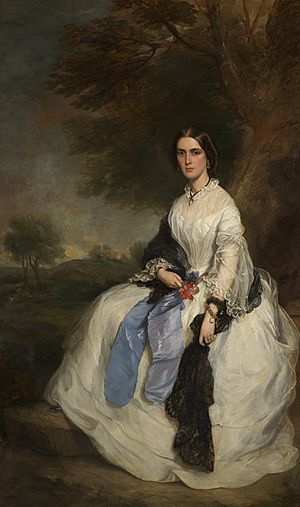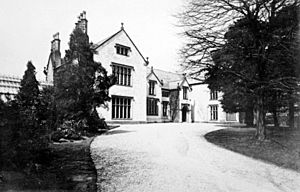John Hick (politician) facts for kids
Quick facts for kids
John Hick
Esq JP
|
|
|---|---|

May 1861 by Francis Grant RA (1803–1878)
|
|
| Born | 2 July 1815 |
| Died | 2 February 1894 (aged 78) Whalley, Lancashire, England
|
| Nationality | British |
| Occupation | Civil and Mechanical engineer Steel manufacturer Politician Company director |
John Hick (2 July 1815 – 2 February 1894) was a very successful English industrialist and art collector. He was also a Conservative Party politician who served in the House of Commons (the UK Parliament) from 1868 to 1880. John Hick and his company, Hick, Hargreaves and Co., were famous for making better steam-engines used in cotton mills around the world.
Contents
His Family and Early Life
John Hick was the oldest son of Benjamin Hick (1790–1842), who was also a civil and mechanical engineer. His father helped improve steam engines. John's mother was Elizabeth Routledge. His uncle, Joshua Routledge, was also an engineer. He invented a special Slide Rule for engineers and improved rotary steam engines.
Education and First Jobs
John Hick went to a private school in Cheshire and then to Bolton Grammar School. There, he learned about business and classic subjects. After school, he started working at his father's engineering company, Benjamin Hick and Son, in Bolton. He helped manage the business from a young age.
After his father passed away in 1842, John became the main boss of the family business. Later, the company became known as Hick, Hargreaves, & Co. In 1845, he became a member of the Institution of Civil Engineers.
John Hick was involved in many parts of his community. He was a Church Warden for St Peter's church in Belmont, Lancashire from 1862 to 1874. He was also a Governor of Bolton Grammar School and a Town councillor for nine years. He was a founding member of the Institution of Mechanical Engineers and a director of the London and North Western Railway from 1871 until he died.
Cool Inventions
In 1839, when John Hick was 23, he won a silver medal from the Royal Society of Arts for his new invention. It was an expanding mandrel used for turning lathes. This tool helped make things on a lathe more easily.
In 1842, he won another silver medal for his invention called an Elliptograph. This device made it simple and accurate to draw different oval shapes. Famous engineers like James Nasmyth and Joseph Whitworth praised his inventions. Models of both his inventions were kept at the Society of Arts.
In 1849, John Hick wrote a paper for the Institute of Mechanical Engineers about a special clutch that could connect and disconnect power from machines. You can even see a small model of his "disconnecting apparatus" for screw propellers from around 1855 at the Science Museum in London!
His Marriages
John Hick married Margaret Bashall (1824–1872) on June 24, 1846. She was the oldest daughter of a factory owner named William Bashall. They had four daughters together.
After Margaret passed away in 1872, John Hick married Rebecca Maria Ashworth (1838–1908) in 1874. She was the sister of his son-in-law.
The Great Exhibition of 1851

The year 1851 was special because of the Crystal Palace Exhibition in Hyde Park. This huge event showed off amazing inventions and art from around the world. John Hick's family business, Benjamin Hick and Son, showed their machines and engineering models there.
John Hick was also chosen to be a Juror (like a judge) for the exhibition. He helped decide which machines and railway equipment were the best. Because he was a juror, his own company couldn't win prizes in the category he was judging.
John Hick also loved art. In 1855, he showed two paintings from his own collection at the Exposition Universelle (1855) in Paris. These were The Stag Hunt and Lady Jane Grey and Roger Ascham by John Callcott Horsley. He also displayed art at the 1857 Art Treasures Exhibition in Manchester.
Bolton Rifles
John Hick helped start the 27th Lancashire Rifle Volunteers, a group of local volunteers who trained to be soldiers. This happened in 1859 because there were worries about tensions between the UK and France. He was offered command of the group but said no.
Bolton Iron and Steel Company
In 1860, John Hick and his business partner William Hargreaves joined with Henry Sharp to create the Bolton Iron & Steel Company. This company made basic metals needed by big factories in the area. They started making Bessemer steel around 1860. They also experimented with other ways to make steel.
The company made things like steel beams for ships and sheet metal for shovels. In 1865, the Bolton Iron & Steel Company made the largest anvil block ever cast in England at the time, weighing a massive 210 tons! By 1869, they were also making steam hammers.

Around 1861, a famous painter named Francis Grant painted portraits of John Hick and his wife Margaret. These paintings hung in their family home, Mytton Hall. John Hick was also interested in photography and supported many artists.
Saving a Famous Train
John Hick wrote a history of Timothy Hackworth's famous locomotive called Sans Pareil. In 1864, he helped restore this old engine and gave it to the Patent Office Museum (which is now the Science Museum). Sans Pareil is now at the National Railway Museum's Shildon Locomotion Museum.
In 1867, John Hick published a paper about his experiments on the friction of leather collars in Hydraulic Presses. This work helped improve how these powerful machines worked.
Serving in Parliament
On November 17, 1868, John Hick was elected as a Member of Parliament (MP) for Bolton. To avoid any unfair situations, he immediately left his job at Hick, Hargreaves and Co. and the Bolton Iron and Steel Company. He served as an MP until March 24, 1880, when he decided not to run again due to poor health.
As an MP, John Hick was a liberal Conservative. He believed that education should include religious teaching and supported the main ideas of the Education Act 1870.
He was very involved in discussions about the safety of people working in factories with steam boilers. In May 1870, he led a special committee to investigate steam boiler explosions. After their report, John Hick introduced a Bill (a proposed law) to help people who were hurt or whose property was damaged by boiler explosions caused by negligence (carelessness).
He also helped discuss important topics like improving heavy cannons for the Army. The government often asked him for advice on armaments (weapons) and building boilers for warships.
John Hick also served on a committee that looked into testing chain cables and anchors for the Navy. He debated about making continuous brakes mandatory for trains, but as a director of the London and North Western Railway, he was cautious about relying too much on automatic machines.
Around 1870, John Hick became a trustee for the estate of a former Bolton mayor, Stephen Blair. They were given the power to build a free hospital for sick people. This hospital, called Blair Hospital, was built on land donated by another former mayor.
John Hick was also a Deputy Lieutenant for Lancashire and a Justice of the Peace for Whalley, Lancashire. He rejoined the Institute of Mechanical Engineers in 1871 and became a Vice-President from 1874 to 1876.
For his contributions to the 1873 International Exhibition in London, John Hick received a bronze medal. He was also part of a committee for the 1874 International Exhibition that helped choose British paintings to display.
In 1879, near the end of his time as an MP, John Hick helped start a company called the Aqueous Works and Diamond Rock-boring Company. This company used diamonds for drilling into rock.
Fighting Pollution
After leaving Parliament, John Hick and Lt-Col. Ralph John Aspinall worked together to fight against the pollution of the River Ribble and its smaller rivers. This pollution was poisoning salmon and trout because of local factories. John Hick had already brought up the issue of pollution in the Ribble during a discussion about the Rivers Pollution Prevention Act 1876.
Aspinall and Hick won a famous legal case in 1880 against the cotton mills of Mitchell and Carlisle. This victory set an important example for controlling environmental pollution. The river ran close to Mytton Hall, where John Hick lived, and the landlord owned the fishing rights. In December 1880, John Hick and Aspinall received awards from the local fishing community for their efforts to stop pollution in the River Ribble.
Helping the Science Museum
In 1887, John Hick was part of a committee that advised the government on creating a Science Museum and a National Gallery of Portraits in South Kensington, London. This shows his dedication to science and history.
His Later Years and Legacy

John Hick passed away at the age of 78 at Mytton Hall in Whalley, Lancashire.
Like his father, John Hick had a very large and valuable collection of art. He spent his last years at Mytton Hall creating a detailed book about his art collection. After his wife Rebecca died in 1908, some of his artworks were sold at auction.
A cool way John Hick was remembered was by the London North Western Railway (LNWR). Starting in the year he died, 1894, the railway company built 10 steam locomotives of the John Hick Class. Engine No. 20 was specifically named John Hick. The other 9 engines were named after famous engineers and inventors from the Industrial Revolution.
John Hick was special because he was the only director of the LNWR to have a whole class of locomotives named after him to honor his memory. Even after the John Hick Class trains were retired in 1912, one of the new George the Fifth Class locomotives, No. 752, was also named John Hick. This train continued to serve until 1935.
Images for kids
See also
- George Forrester and Company
- Johann Georg Bodmer
- Gerasim Ivanovich Khludov







